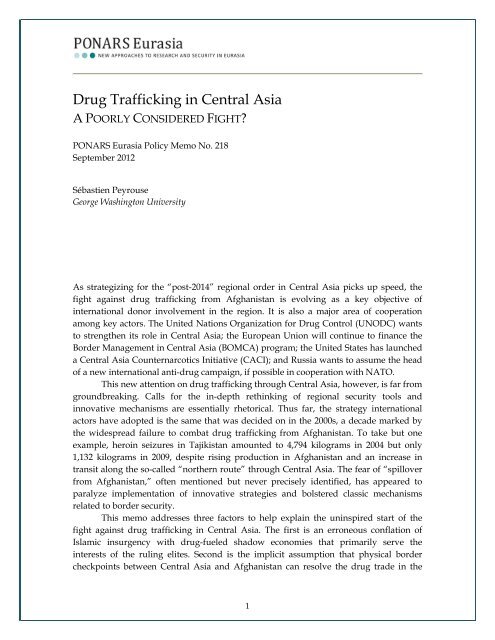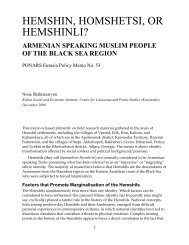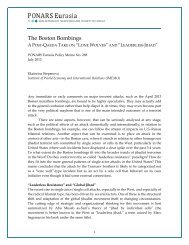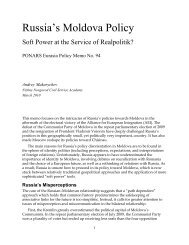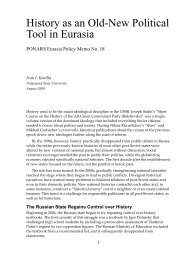Drug Trafficking in Central Asia - PONARS Eurasia
Drug Trafficking in Central Asia - PONARS Eurasia
Drug Trafficking in Central Asia - PONARS Eurasia
Create successful ePaper yourself
Turn your PDF publications into a flip-book with our unique Google optimized e-Paper software.
<strong>Drug</strong> <strong>Traffick<strong>in</strong>g</strong> <strong>in</strong> <strong>Central</strong> <strong>Asia</strong><br />
A POORLY CONSIDERED FIGHT?<br />
<strong>PONARS</strong> <strong>Eurasia</strong> Policy Memo No. 218<br />
September 2012<br />
Sébastien Peyrouse<br />
George Wash<strong>in</strong>gton University<br />
As strategiz<strong>in</strong>g for the “post-2014” regional order <strong>in</strong> <strong>Central</strong> <strong>Asia</strong> picks up speed, the<br />
fight aga<strong>in</strong>st drug traffick<strong>in</strong>g from Afghanistan is evolv<strong>in</strong>g as a key objective of<br />
<strong>in</strong>ternational donor <strong>in</strong>volvement <strong>in</strong> the region. It is also a major area of cooperation<br />
among key actors. The United Nations Organization for <strong>Drug</strong> Control (UNODC) wants<br />
to strengthen its role <strong>in</strong> <strong>Central</strong> <strong>Asia</strong>; the European Union will cont<strong>in</strong>ue to f<strong>in</strong>ance the<br />
Border Management <strong>in</strong> <strong>Central</strong> <strong>Asia</strong> (BOMCA) program; the United States has launched<br />
a <strong>Central</strong> <strong>Asia</strong> Counternarcotics Initiative (CACI); and Russia wants to assume the head<br />
of a new <strong>in</strong>ternational anti-drug campaign, if possible <strong>in</strong> cooperation with NATO.<br />
This new attention on drug traffick<strong>in</strong>g through <strong>Central</strong> <strong>Asia</strong>, however, is far from<br />
groundbreak<strong>in</strong>g. Calls for the <strong>in</strong>-depth reth<strong>in</strong>k<strong>in</strong>g of regional security tools and<br />
<strong>in</strong>novative mechanisms are essentially rhetorical. Thus far, the strategy <strong>in</strong>ternational<br />
actors have adopted is the same that was decided on <strong>in</strong> the 2000s, a decade marked by<br />
the widespread failure to combat drug traffick<strong>in</strong>g from Afghanistan. To take but one<br />
example, hero<strong>in</strong> seizures <strong>in</strong> Tajikistan amounted to 4,794 kilograms <strong>in</strong> 2004 but only<br />
1,132 kilograms <strong>in</strong> 2009, despite ris<strong>in</strong>g production <strong>in</strong> Afghanistan and an <strong>in</strong>crease <strong>in</strong><br />
transit along the so-called “northern route” through <strong>Central</strong> <strong>Asia</strong>. The fear of “spillover<br />
from Afghanistan,” often mentioned but never precisely identified, has appeared to<br />
paralyze implementation of <strong>in</strong>novative strategies and bolstered classic mechanisms<br />
related to border security.<br />
This memo addresses three factors to help expla<strong>in</strong> the un<strong>in</strong>spired start of the<br />
fight aga<strong>in</strong>st drug traffick<strong>in</strong>g <strong>in</strong> <strong>Central</strong> <strong>Asia</strong>. The first is an erroneous conflation of<br />
Islamic <strong>in</strong>surgency with drug-fueled shadow economies that primarily serve the<br />
<strong>in</strong>terests of the rul<strong>in</strong>g elites. Second is the implicit assumption that physical border<br />
checkpo<strong>in</strong>ts between <strong>Central</strong> <strong>Asia</strong> and Afghanistan can resolve the drug trade <strong>in</strong> the<br />
1
absence of a political will to fight corruption. The third is an excessive focus on security<br />
as opposed to demand reduction and treatment.<br />
Confus<strong>in</strong>g Insurgency and <strong>Drug</strong> <strong>Traffick<strong>in</strong>g</strong><br />
The official narrative of <strong>Central</strong> <strong>Asia</strong>n governments, echoed by all regional structures<br />
<strong>in</strong>volved <strong>in</strong> the fight aga<strong>in</strong>st drugs, is that terrorism and narcotics are <strong>in</strong>tr<strong>in</strong>sically<br />
l<strong>in</strong>ked. In <strong>Central</strong> <strong>Asia</strong>, this assumption has been legitimized by the Islamic Movement<br />
of Uzbekistan’s well-documented <strong>in</strong>volvement <strong>in</strong> drug traffick<strong>in</strong>g <strong>in</strong> its <strong>in</strong>cursions <strong>in</strong>to<br />
Tajikistan and Kyrgyzstan dur<strong>in</strong>g the summers of 1999 and 2000. The l<strong>in</strong>kage between<br />
terrorism and drugs <strong>in</strong> Afghanistan, however, is based on a very simplistic read<strong>in</strong>g of<br />
the Afghan situation, whereby drug traffick<strong>in</strong>g is just one way that the Taliban and their<br />
allies f<strong>in</strong>ance their activities.<br />
It is necessary to deconstruct the conflation of drug traffick<strong>in</strong>g and Islamist<br />
<strong>in</strong>surgency. This <strong>in</strong>terpretation says noth<strong>in</strong>g about the complexity of realities on the<br />
ground, <strong>in</strong>clud<strong>in</strong>g the lack of alternative agricultural opportunities for Afghan farmers,<br />
the role of warlords and patronage mechanisms, and the deep <strong>in</strong>volvement of the whole<br />
adm<strong>in</strong>istrative apparatus <strong>in</strong> the drug <strong>in</strong>dustry. In particular, this fram<strong>in</strong>g says noth<strong>in</strong>g<br />
about the predom<strong>in</strong>ance of crim<strong>in</strong>alized structures with political connections <strong>in</strong> high<br />
places. Indeed, <strong>in</strong> Afghanistan, drug traffick<strong>in</strong>g has become an official activity as much—<br />
if not more—than it is an <strong>in</strong>surgent one. Accord<strong>in</strong>g to UNODC figures, <strong>in</strong> 2009 Afghan<br />
traffickers made an estimated $2.2 billion <strong>in</strong> profits, while <strong>in</strong>surgent groups made only<br />
$155 million. A similar profit-shar<strong>in</strong>g proportion exists <strong>in</strong> <strong>Central</strong> <strong>Asia</strong>, where experts<br />
tend to separate the drug trade <strong>in</strong>to three different types represented by the colors<br />
green, black, and red.<br />
• “Green” refers to traffick<strong>in</strong>g organized by clandest<strong>in</strong>e Islamist movements to<br />
self-f<strong>in</strong>ance their operations. Its share of total drug profits is relatively low.<br />
• “Black” consists of the traffick<strong>in</strong>g of m<strong>in</strong>imal quantities by small crim<strong>in</strong>al groups<br />
or <strong>in</strong>dividuals at high personal risk (conceal<strong>in</strong>g drugs on their body or <strong>in</strong><br />
cloth<strong>in</strong>g, suitcases, and so on) <strong>in</strong> order to supply local markets.<br />
• “Red” refers to the largest share of the drug trade, organized by larger crim<strong>in</strong>al<br />
structures with the support of some senior officials.<br />
The dist<strong>in</strong>ction between the “black” and “red” types of drug traffick<strong>in</strong>g is<br />
sometimes ambiguous. In particular, the relevant mechanisms of corruption <strong>in</strong> law<br />
enforcement agencies, border guards <strong>in</strong> particular, can appear to be the same. However,<br />
two differences may be observed. First, black traffick<strong>in</strong>g <strong>in</strong>volves far more limited<br />
quantities than the red one. Second, black traffick<strong>in</strong>g presupposes corruption at lower<br />
echelons of the adm<strong>in</strong>istrative cha<strong>in</strong> and depends on the clandest<strong>in</strong>e transportation of<br />
drugs. Red traffick<strong>in</strong>g, on the other hand, is based on a well-structured pyramidal<br />
hierarchy that guarantees the smooth operation of the transport cha<strong>in</strong> and distribution<br />
network.<br />
2
National drug fight<strong>in</strong>g agencies <strong>in</strong> <strong>Central</strong> <strong>Asia</strong>, which often act only under<br />
pressure from the <strong>in</strong>ternational community, exclusively target the black and green<br />
sectors, leav<strong>in</strong>g the red one totally untouched. On the rare occasions when red<br />
traffick<strong>in</strong>g is uncovered, this is typically assumed to reflect the settl<strong>in</strong>g of scores among<br />
elites who have just had a political or commercial rival struck down. In Tajikistan, the<br />
fact that members of the presidential family are at the head of national agencies confirms<br />
the em<strong>in</strong>ently political nature of these <strong>in</strong>stitutions (the same was true <strong>in</strong> Kyrgyzstan<br />
under former president Kurmanbek Bakiyev).<br />
External actors that accept the narrative of <strong>Central</strong> <strong>Asia</strong>n governments on jo<strong>in</strong>tly<br />
fight<strong>in</strong>g terrorism and drug traffick<strong>in</strong>g <strong>in</strong>directly help to legitimize domestic policies of<br />
repression and rent-seek<strong>in</strong>g strategies. It is easier for <strong>Central</strong> <strong>Asia</strong>n governments to<br />
secure outside support by emphasiz<strong>in</strong>g the risk of terrorism and present<strong>in</strong>g themselves<br />
as victims, weakened by “spillover” from Afghanistan. This diverts attention from their<br />
own responsibility for the drug trade and legitimizes the repression of local Islamist<br />
movements by fus<strong>in</strong>g notions of political opposition, Islamist extremism, and the drug<br />
trade.<br />
The Border Security Illusion<br />
Def<strong>in</strong><strong>in</strong>g drug traffick<strong>in</strong>g as a “spillover” effect from Afghanistan also leads to a poor<br />
assessment of the mechanisms that are needed to counter it. International <strong>in</strong>stitutions<br />
are focused on improv<strong>in</strong>g border security, pr<strong>in</strong>cipally its material aspects (like<br />
build<strong>in</strong>gs, <strong>in</strong>frastructure, and equipment), aga<strong>in</strong> <strong>in</strong> accordance with the needs that local<br />
authorities express. In a recent report published by the Open Society Foundations,<br />
George Gavrilis showed how a focus on personnel tra<strong>in</strong><strong>in</strong>g came much later, notably<br />
with<strong>in</strong> the BOMCA framework. It is, of course, true that <strong>Central</strong> <strong>Asia</strong>n states need better<br />
border security. Their border guards require better material conditions and tra<strong>in</strong><strong>in</strong>g <strong>in</strong><br />
new technologies and best practices. And as new states on the <strong>in</strong>ternational scene, they<br />
require foreign assistance to rise to <strong>in</strong>ternational standards.<br />
However, it is naïve to assume that the fight aga<strong>in</strong>st drug traffick<strong>in</strong>g can be<br />
waged successfully with such measures. To secure a border with checkpo<strong>in</strong>ts, barbed<br />
wire, and watchtowers is not enough to make the frontier impermeable, as the recurrent<br />
failure of the United States to “close” its southern border with Mexico has shown. In<br />
<strong>Central</strong> <strong>Asia</strong>, all border po<strong>in</strong>ts, even those that the <strong>in</strong>ternational community has best<br />
equipped, are open borders, as corruption has rendered them permeable. Every entry<br />
<strong>in</strong>to <strong>Central</strong> <strong>Asia</strong>n territory can be negotiated (by buy<strong>in</strong>g a false passport, brib<strong>in</strong>g a<br />
border guard to forego a document check, and so on). The smaller-scale “black” and<br />
“green” drug traffickers are the only ones that try to get across borders by avoid<strong>in</strong>g<br />
checkpo<strong>in</strong>ts, through mounta<strong>in</strong> passes or across rivers. The “red” traffic, on the other<br />
hand, utilizes the ma<strong>in</strong> roads and official checkpo<strong>in</strong>ts, recently upgraded with the<br />
<strong>in</strong>ternational community’s assistance.<br />
<strong>Central</strong> <strong>Asia</strong>n borders with Afghanistan cannot be made secure by physical<br />
means alone. It requires the political will to fight aga<strong>in</strong>st corruption, and for the longterm.<br />
To be effective, efforts to combat drug traffick<strong>in</strong>g <strong>in</strong> <strong>Central</strong> <strong>Asia</strong> must therefore be<br />
3
first political <strong>in</strong> nature. This does not only mean gett<strong>in</strong>g the pr<strong>in</strong>cipled consent of<br />
<strong>Central</strong> <strong>Asia</strong>n governments. It also requires establish<strong>in</strong>g measures similar to those <strong>in</strong><br />
Colombia several years ago or those Mexico tries to implement today: forcibly<br />
separat<strong>in</strong>g crim<strong>in</strong>al networks from their pawns <strong>in</strong> the state apparatus and fight<strong>in</strong>g real<br />
wars, likely with casualties, aga<strong>in</strong>st drug cartels.<br />
Such an approach is unlikely to obta<strong>in</strong> the support of <strong>Central</strong> <strong>Asia</strong>n rul<strong>in</strong>g elites<br />
today, however, and the <strong>in</strong>ternational community cannot force it upon them. Border<br />
security thus will rema<strong>in</strong> the lowest common denom<strong>in</strong>ator for <strong>in</strong>ternational cooperation,<br />
requir<strong>in</strong>g important f<strong>in</strong>ancial commitments for more than limited effectiveness.<br />
From Supply to Demand<br />
International efforts to combat drug traffick<strong>in</strong>g from Afghanistan are dist<strong>in</strong>ctly focused<br />
more on production and manufacture than they are on demand reduction, treatment,<br />
and prevention campaigns. Strategies of prevention and treatment are considered<br />
national issues dependent on public policy, while the fight aga<strong>in</strong>st drug traffick<strong>in</strong>g is<br />
held to be the legitimate prov<strong>in</strong>ce of <strong>in</strong>ternational and regional organizations. Thus, for<br />
example, UNODC’s budget for <strong>Central</strong> <strong>Asia</strong> allocates only 11 percent of its funds to<br />
prevention, while 88 percent is assigned directly to the fight aga<strong>in</strong>st drugs as well as<br />
aga<strong>in</strong>st organized crime, corruption, and terrorism.<br />
International actors’ strategies for fight<strong>in</strong>g aga<strong>in</strong>st traffick<strong>in</strong>g have been subject<br />
to contradictory <strong>in</strong>terpretations. Russia, for example, wants NATO to go directly after<br />
production by destroy<strong>in</strong>g poppy fields and laboratories. In this context, the Russian<br />
government has put forward a “Ra<strong>in</strong>bow-2” plan, a large scale poppy eradication<br />
program, and has lobbied the UN Security Council to have Afghan production declared<br />
a threat to global peace and security. Such a decision would enable sanctions to be<br />
imposed on Afghan landowners who authorize the cultivation of opium, as well as<br />
legitimize the destruction of poppy fields. However, NATO has refused to accede to<br />
Russian demands, on the pretext that it would be necessary to provide Afghan farmers<br />
alternative sources of revenue or risk worsen<strong>in</strong>g the image of the organization among<br />
the Afghan population. It has stated that it wants to focus eradication efforts aga<strong>in</strong>st<br />
drug storage sites, so that the losses <strong>in</strong>flicted are targeted only at crim<strong>in</strong>al sett<strong>in</strong>gs.<br />
When it comes to treatment, all <strong>Central</strong> <strong>Asia</strong>n states are affected by their Soviet<br />
heritage. As the studies of historian and anthropologist Alisher Latypov have shown,<br />
the Soviet past, which places the medical and psychiatric doma<strong>in</strong>s at the service of law<br />
enforcement agencies, still carries great <strong>in</strong>fluence. The tendency to crim<strong>in</strong>alize drug<br />
addicts complicates the implementation of effective prevention strategies. Alleg<strong>in</strong>g a<br />
synergy between <strong>in</strong>surgency, terrorism, and drugs does not lend itself to form<strong>in</strong>g new<br />
approaches or creat<strong>in</strong>g more appropriate support structures for persons requir<strong>in</strong>g care.<br />
Several <strong>Central</strong> <strong>Asia</strong>n states, for <strong>in</strong>stance, require treatment centers to transmit the<br />
names of drug addicts to security organizations. Moreover, treatment centers are poorly<br />
equipped and oriented around abst<strong>in</strong>ence and zero tolerance. While Kyrgyzstan has<br />
accepted opioid substitution therapy, the latter rema<strong>in</strong>s quite controversial <strong>in</strong> most post-<br />
Soviet states, and Turkmenistan, Uzbekistan, and Kazakhstan are vehemently opposed<br />
4
to it. In Uzbekistan, substitution therapy was termed “<strong>in</strong>appropriate” by the M<strong>in</strong>istry of<br />
Health and banned <strong>in</strong> 2009, while <strong>in</strong> Kazakhstan a recent official evaluation group<br />
concluded that substitution therapy is a “security threat” to the nation.<br />
Conclusion<br />
There is no easy solution for drug traffick<strong>in</strong>g from Afghanistan, whether <strong>in</strong> terms of its<br />
impact on public health or the shadow economy it generates. The states of <strong>Central</strong> <strong>Asia</strong><br />
cannot fight the problem alone. They are located on transit routes from Afghan<br />
production sites to Russian and European consumers. For the most part, they are limited<br />
<strong>in</strong> their abilities to allocate funds to the fight, to tra<strong>in</strong> personnel, and to build responsive<br />
policies. They must also contend with an underly<strong>in</strong>g geopolitical competition, which<br />
sometimes creates rivalry between U.S. and Russian projects while turn<strong>in</strong>g NATO and<br />
UNODC platforms <strong>in</strong>to arenas of power projection.<br />
However, these limitations do not legitimize the poor assessment of external<br />
donors or strategies that are based on myths propagated by <strong>Central</strong> <strong>Asia</strong>n authorities.<br />
These myths render the efforts of the <strong>in</strong>ternational community both costly and largely <strong>in</strong><br />
va<strong>in</strong>. If “post-2014 stability” <strong>in</strong> <strong>Central</strong> <strong>Asia</strong> is to be a real strategic goal and not just<br />
rhetoric, the drug trade from Afghanistan merits a more courageous assessment.<br />
© <strong>PONARS</strong> <strong>Eurasia</strong> 2012. <strong>PONARS</strong> <strong>Eurasia</strong> is an <strong>in</strong>ternational network of<br />
academics that advances new policy approaches to research and security <strong>in</strong><br />
Russia and <strong>Eurasia</strong>. <strong>PONARS</strong> <strong>Eurasia</strong> is based at the Institute for European,<br />
Russian and <strong>Eurasia</strong>n Studies (IERES) at George Wash<strong>in</strong>gton University’s Elliott<br />
School of International Affairs. The publication was made possible by grants<br />
from Carnegie Corporation of New York and the John D. and Cather<strong>in</strong>e T.<br />
MacArthur Foundation. www.ponarseurasia.org<br />
5


